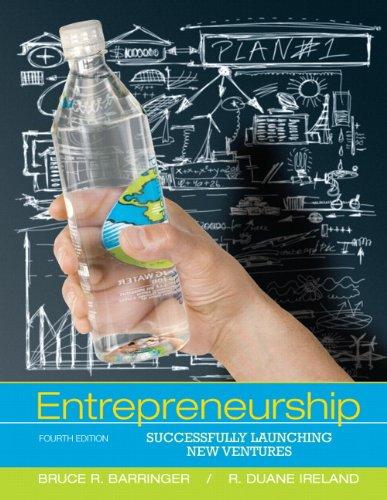When trying to solve a problem, one thing to be mindful of is that there is typically
Question:
When trying to solve a problem, one thing to be mindful of is that there is typically more than one way to tackle it. A vivid example of this is the problem that hospitals and clinics have with health care–associated infections. About 1.7 million people each year contract health care–associated infections. These are infections that patients acquire during the course of receiving treatment. You might be surprised to learn that health care–associated infections are the most common complication of hospital care and are one of the 10 leading causes of death in the United States. According to a recent study by the Centers for Disease Control and Prevention, the total cost of health care–associated infections is between $28 billion and $34 billion per year. That figure includes direct medical costs, the indirect costs related to lost productivity, and the intangible costs related to diminished quality of life. The most direct financial burden is felt by health care providers themselves. Of the $28 billion to $34 billion determined by the Centers for Disease Control and Prevention study, approximately $6.65 billion is borne by the U.S. health care industry.
Obviously, health care–associated infections are a problem. The question is how to best solve the problem. It turns out there is no single answer. Health care–associated infections are caused by a wide range of common and unusual bacteria, fungi, and viruses that are brought into a health care setting through improper sterilization of medical equipment, improper hygiene on the part of health care workers, bacteria brought in by guests visiting patients, and for many other reasons. Because there is no silver bullet to simultaneously eliminate all health care–associated inflections, it’s a wide open field for entrepreneurs, and health care providers are typically eager to vet solutions with the potential to reduce the number of infections that patients contract while in their care.
Two recent start-ups are tackling the challenge of health care–associated infections in innovative, yet very different ways. The first is Xhale, which was started in 2008, and makes HyGreen, a hand washing compliance system. According to the company, of all the high-tech machines in a modern hospital, the simple hand soap dispenser may be the best defense against health care–associated infections. The problem is that despite all the education and warnings, according to recent studies, health care workers still wash their hands less than half the time after direct contact with patients.
The excuses are many—too little time, rushing to an emergency, or simply forgetfulness. Here’s how HyGreen works. After cleaning their hands with an alcohol-based sanitizer (soap or gel), a health care worker places his or her hands under a HyGreen sensor that sniffs for alcohol.
When sufficient alcohol is present, indicating that the worker’s hands are clean, the device sends a wireless “all clear” message to a badge worn by the worker. A wireless monitor mounted above each patient’s bed is able to tell if an approaching worker has received an “all clear”
message recently. If the worker hasn’t, his or her badge vibrates, reminding the worker to wash his or her hands.
All interactions are recorded in real time, showing who is and who isn’t washing their hands. This data allows hospital administrators to analyze who is washing their hands and who isn’t, and provides them the information they need to distribute rewards or take corrective action as they see fit.
The second start-up tackling health care–associated infections is Vestagen, albeit in a very different manner.
Launched in 2009, this company hopes to reduce the number of infections with a new type of fabric for hospital scrubs, lab coats, and isolation gowns. The nanotechnology-
based material, which is called Vestex, repels blood and body fluids, resists stains, contains an antimicrobial to prevent degradation from micro organisms, and reduces perspiration odor. The idea is that health care workers’ uniforms can harbor high levels of microorganisms—just the type of microorganisms that lead to health care–associated infections. By keeping health care workers’ uniforms cleaner and more bacteria free, the spread of containments from health care worker to patent is greatly reduced. The product also provides health care workers increased peace of mind when they leave the hospital or clinic and return home in that these individuals can transmit bacteria, fungi, and viruses from their uniforms to their families just as easily as they can to patients at work.
The technology behind the Vestex fabric is licensed from Schoeller, a large Swiss textiles company. As Vestagan expands its offerings, it hopes to incorporate its technology into patient gowns, bed linens, and clinical privacy curtains.
Questions for Critical Thinking
1. Evaluate Xhale’s idea and Vestagen’s idea on all four dimensions of an opportunity. Rank each idea on a scale of 1 to 5 (5 is high) regarding how strongly it satisfies the four dimensions.
2. Along with “solving a problem,” are the strengths of Xhale and Vestagen’s business ideas bolstered by environmental trends? If so, how powerful are these trends and how much do they strengthen Xhale’s and Vestagen’s business concepts?
3. Do some brainstorming and come up with an additional idea for helping reduce health care–associated infections. How would you go about vetting your idea to see if it is realistic?
4. Do some Internet research to learn about the founders of both Xhale and Vestagen. To what degree does each founder reflect the personal characteristics that tend to make some people better at recognizing opportunities than others?
Step by Step Answer:

Entrepreneurship Successfully Launching New Ventures
ISBN: 9780132555524
4th Edition
Authors: Bruce R. Barringer, R. Duane Ireland





